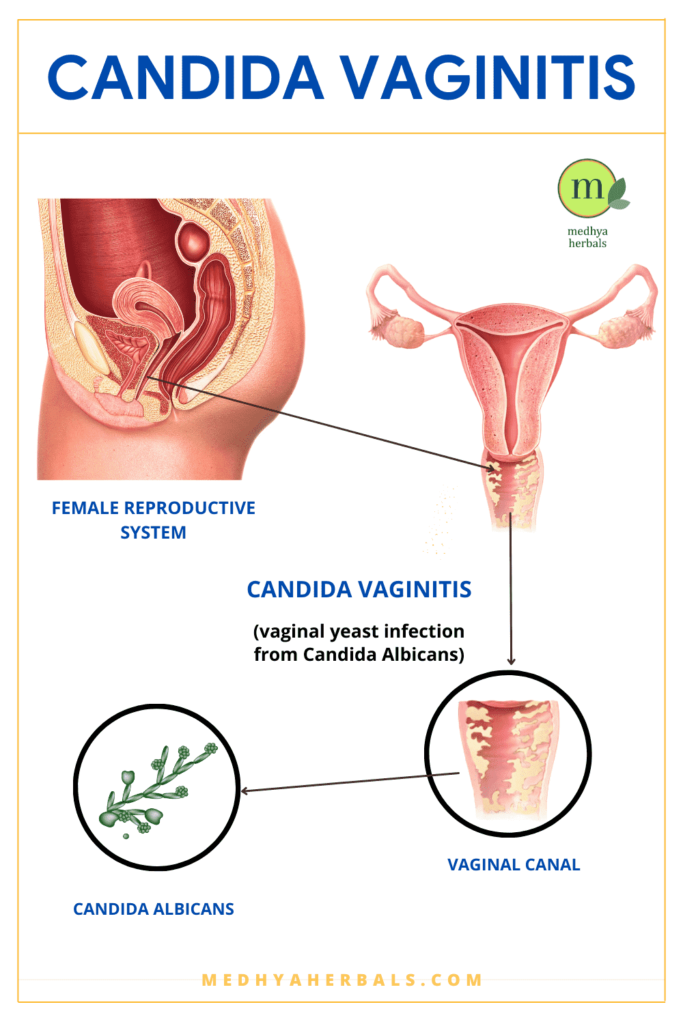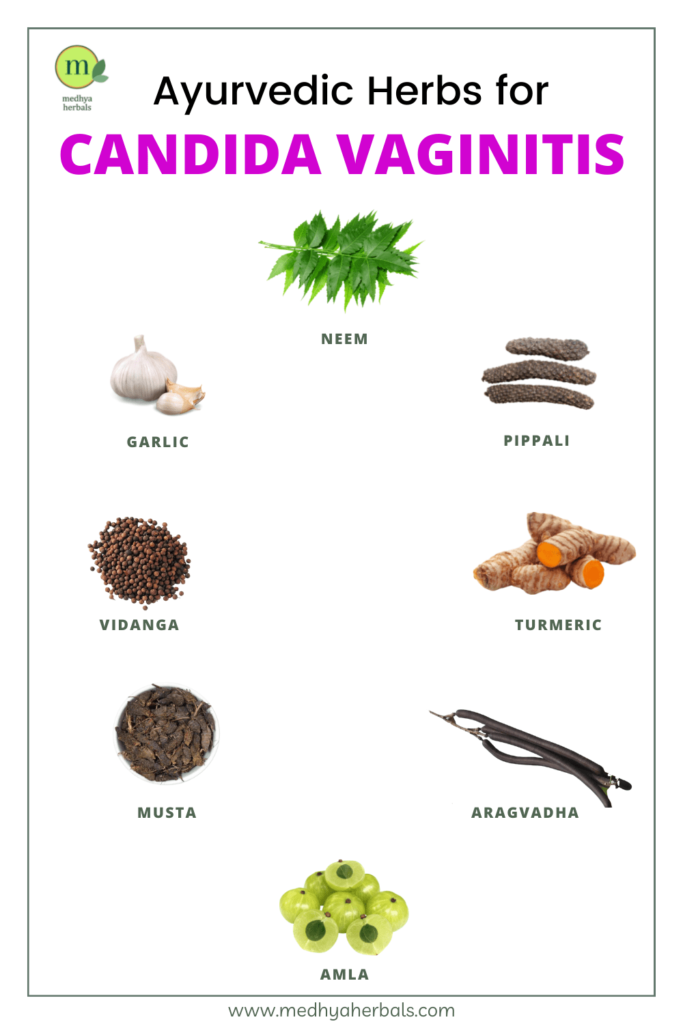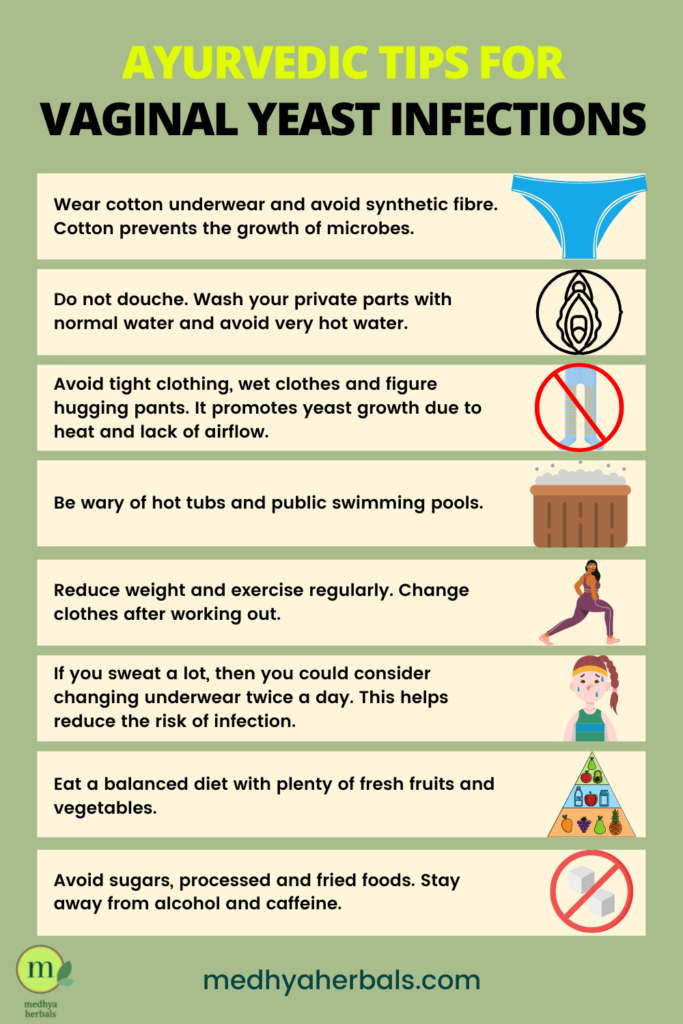If you are one of the many women who suffer from vaginal yeast infections, you know that they can be both embarrassing and frustrating. Not only are they uncomfortable, but they can also be quite painful.
Vaginal Candidiasis, also known as vaginal thrush or candida vaginitis is a yeast infection that is caused by an overgrowth of the Candida albicans fungus. This fungus is normally present in small amounts in the vagina, but it can grow out of control if the vaginal pH balance is disrupted. When this happens, it can lead to symptoms like vaginal itching, burning, and vaginal yeast infection discharge.
The good news is that there are highly effective treatments for yeast infections that are natural and safe. In this blog post, we will discuss some of the best Ayurvedic solutions for vaginal thrush and how it can help you get rid of your vaginal infection quickly!
What is Vaginal Candidasis?
There is a vaginal flora of microorganisms, just as there is a flora in the mouth, throat, gut, skin, etc, and this is not a problem. But, when there is a spike in relative levels of one of the group of microbes making up this flora, it results in a vaginal yeast infection.
Vaginitis is an infection of the vagina. The particular type or name of the infection depends on the kind of disturbance that occurs or the microbe causing it, and it could be a:
- Bacterial vaginitis;
- Fungal vaginitis of candidasis or vaginal candidiasis
- Viral vaginitis;
- Chlamydia;
- Gonorrohea;
- Trichomoniasis, etc.
In the fungal vaginal infection, there is a spike in level of fungi, specifically yeast (a type of fungus). So, this infection is alternatively referred to as vaginal candidasis, vulvovaginal candidasis, candidal vaginitis, or simply vaginal thrush and fungal or vaginal yeast infections.

Symptoms of Candida Vaginitis
The symptoms that present in a case of vaginal candidasis include:
- Vaginal itching or soreness;
- Pain or discomfort during urination;
- Painful sexual intercourse;
- Vaginal rashes or thrush
- Abnormal vaginal discharge;
- Unpleasant odour
These symptoms are usually mild and, therefore, resolve within a few days to a few weeks. In fact, 20% of women have candida in the vagina with no symptoms presented. However, if left untended and not managed properly, the yeast infection symptoms become severe with redness, swelling and cracks in the vaginal wall.
The microbes can also multiply so much that, consequently, they begin to go deeper into the body, causing various complications.
In addition, 75% of women have candida vaginitis at least twice in their lifetime.
Ayurvedic View of Vaginal Yeast Infections
Infections or health problems that affect the vagina fall in the category of diseases termed as yoni vyapat in Ayurveda. Yoni is a term used to refer to the sexual organs in Ayurveda, and is associated with the female reproductive system.
In Ayurveda, vaginal yeast infection is considered to be caused by an imbalance of the Pitta dosha. This dosha governs the fire element in the body and is responsible for digestion, metabolism, and skin health.
When Pitta is out of balance, it can lead to a build-up of toxins in the body, which can then lead to bacterial and yeast infections.
Additionally, kapha dosha imbalance affects the growth and propagation of yeast or fungus. Kapha is essentially regulator of the water and earth element in the body. When Kapha is high, it leads to stagnation, water retention and internal conditions for growth of yeast.
Here’s how fungal infections in vagina develop
- When the agni (digestive fire) is weak (mandagni), there is in turn incomplete digestion (ajeerna). The ama is then absorbed into the bloodstream (amarasa).
- The vagina, being a potential kapha zone due to the viscous fluids secreted there, gets a deposition of the ama, alongside the intestine, oral cavity and skin folds such as below the breasts, under the arms, in the folds of the neck and thighs etc.
- Presence of Ama weakens the normal functioning of affected body organ, leading to poor circulation and blockade. This further weakens the immune system and allows bacteria or yeast to flourish unabated.
Thus development of infections in vagina happens. This leads to symptoms as:
- Kandu (itching);
- Shatalata (coldness);
- Alpavedana (low-grade pain);
- Pichhilata (mucoid secretions);
- Shwetapreadara (leucorrhoea);
and these findings correlate with the modern findings as regards this disease.
What Causes Candida Vaginitis?
Simply said, the candida vaginitis is caused by a fungal infection, precisely the yeast. However, some factors can increase the risk for this disease, either by disturbing pH of the vagina or by aiding the fungi along in the process of infection. These include:
- The use of hormonal contraceptives, sperm killers or birth control pills.
- Diabetes, due to high sugar levels in the blood. High sugar levels suppresses the immune system.
- Decreased immunity due to diseases such as HIV.
- High estrogen levels, such as seen in pregnant women or those taking birth control pills high in estrogen, or undergoing estrogen hormone therapy.
- Use of antibiotics-antibiotics attack healthy bacteria, killing them off. This gives the fungi a chance to proliferate beyond measure, leading to yeast infection.
- Adyashana, that is, eating excess food.
- Viruddhahara, meaning, eating incompatible foods combinations.
- Wearing tight-fitting clothing or underwear that doesn’t allow the vagina to breathe
- Douching
- Using scented vaginal hygiene products
Who is at risk for vaginal yeast infections?
Vaginal yeast infections are most common in women of childbearing age, but they can occur in women of all ages. Other factors that can increase your risk of developing a vaginal yeast infection include:
Conventional Treatment to Remove Yeast Infection in the Vagina
In modern medicine, candida vaginitis is cured by using anti-fungal drugs, since it is a yeast infection. The medication may be taken orally or applied inside the vagina.
- Oral Medication: fluconazole.
- Medication to be applied inside the vagina: boric acid, mystatin, flucytosine.
Another option available is to take hormones in order to balance hormonal levels, should in case the infection has been triggered by hormonal imbalance.
Ayurvedic Natural Treatment for Vaginal Yeast Infections
There are a number of Ayurvedic medicines that can be used to treat vaginal thrush, including turmeric, neem, triphala, and amalaki. These herbs have anti fungal and immune boosting properties that can help to remove the infection permanently.
Treating vaginal thrush with Ayurveda is a safe and effective way to get rid of the infection quickly. Ayurvedic natural treatment for vaginal yeast infections involves use of Ayurvedic medicines, diet and lifestyle changes to detoxify and remove the harmful secretions of the candida, build up the immunity “ojas” and restore the digestive fire to prevent toxin build up “ama” and hence growth of yeast in the body.
Ayurvedic Treatment for Vaginal Candidiasis follows these steps:
- Detoxification – Virechana
- Support Digestive Fire – Agni Deepan
- Boost Immunity – Ojas
- Balance hormones and support natural functioning of the the reproductive system “yoni”
1. Ayurvedic Medicines and Herbal Remedies for Yeast Infections
Ayurvedic medicines have anti fungal and antioxidant properties that support immune system and prevent the growth of yeast in the body. Some of the most effective Ayurvedic herbs for vaginal yeast infections include:

Neem: Neem is a powerful antibacterial herb that can help to fight off the infection-causing bacteria.
Turmeric: Turmeric is a potent anti-inflammatory herb that can help to soothe vaginal irritation and inflammation.
Garlic: Garlic is a natural antifungal agent that can help to kill off the overgrowth of candida fungus.
Indian Gooseberry: Indian gooseberry is a rich source of vitamin C, which can help to boost the immune system and fight off infection.
Vidanga: Vidanga is an Ayurvedic herb that has potent anti-fungal properties. It can be used to treat vaginal thrush as well as other fungal infections.
Pippali: Pippali is an Ayurvedic herb that helps to improve digestion and metabolism. It can also help to fight off infection by boosting the immune system.
Aragvadha: Aragvadha is an Ayurvedic herb that has powerful anti-inflammatory and antifungal properties. It can be used to treat vaginal thrush as well as other vaginal infections.
Musta: Musta is an Ayurvedic herb that helps to detoxify the body and fight off infection. It can be used to treat vaginal thrush.
These are just some of the most effective Ayurvedic herbs for treating vaginal thrush. For best results, it is advisable to consult with a qualified Ayurvedic practitioner who can prescribe the right herbs and dosages for your specific condition.
2. Ayurvedic Lifestyle to Treat Vaginal Yeast Infections
There are a number of lifestyle changes that you can make to help treat yeast infections. These include:

- Wear cotton underwear. Cotton encourages aeration/ventilation of the vagina. Cotton also absorbs moisture easily. On the other hand, nylon underwear choke the vagina, preventing the flow of air. This kind of situation encourages the proliferation of microbes.
- Do not douche. The practice of douching removes healthy microbes and causes an imbalance to the vaginal flora. Consequently, there is a proliferation of one type of microbe more than the others, and this causes infections.
- Avoid tight clothes. They create a similar consequence as nylon underwear. The heat and lack of air that results from wearing tight clothes create an ideal environment for breeding of microbes.
- Be wary of hot tubs.
- Do not wear wet clothes like swimsuits, exercise gear, underwear, and so on, for extended periods. If you do, however, you thus encourage the proliferation of microbes.
- Don’t suppress natural urges, that is, urination and defecation.
- Avoid the use of strong soaps, rather use mild soaps.
- Public swimming pools can be a brewery for infectious microbes, and should not be overindulged in.
- If you sweat a lot, then you could consider changing underwear twice a day. This helps reduce the risk of infection.
3. Ayurvedic Diet for a Healthy Vaginal Flora
One of the best ways to treat vaginal yeast infections is to make sure that you are eating a healthy diet. A diet that is high in sugar and refined carbohydrates can promote the growth of candida fungus.
Therefore, it is important to eat plenty of fresh fruits and vegetables, as well as whole grains and proteins. You should also avoid sugary foods, alcohol, and caffeine.
Additionally, Ayurvedic Diet habits for curing and/or keeping off vaginal infections include:
- Embrace freshly prepared meals that are easily digestible.
- Rasonam (garlic), yava (oats), pippali, and seedhu should be your favorite spices. Spices help build up the digestive fire.
- Take more of meat soups, milk, fresh fruits and vegetables.
- Avoid cold food as they weaken the agni.
- Yogurt contains live cultures of beneficial bacteria, which can help to restore the balance of good bacteria in the vagina.
Takeaway
Ayurveda is a holistic system of medicine that can be used to treat a wide range of conditions, including vaginal thrush. Ayurvedic herbs and dietary changes can help to restore the balance of good bacteria in the vagina, which can provide long-term relief from vaginal thrush.
In addition, lifestyle changes and vaginal hygiene practices can also help to prevent and treat vaginal yeast infections. If you are suffering from vaginal thrush, consult with a qualified Ayurvedic practitioner to find the best treatment plan for you.
Consult with Medhya’s Ayurvedic Doctor to get your personalised health plan involving prescription for Ayurvedic medicine, diet, yoga and lifestyle guidelines.
Frequently Asked Questions
1. Can vaginal yeast infection be cured?
Yes, most vaginal yeast infection can be cured with the right treatment. However, some women may experience recurrent or chronic infection that require long-term treatment.
2. How can I prevent vaginal yeast infection?
You can prevent vaginal yeast infection by practicing good vaginal hygiene, avoiding tight-fitting clothing and synthetic fabrics, and eating a healthy diet.
3. What are the symptoms of vaginal yeast infection?
Symptoms of vaginal yeast infection include itching, burning, and redness in the vagina and vulva. Some women may also experience soreness, pain during urination or sex, and discharge.
4. Why do we get yeast infection in private parts?
Vaginal yeast infections are caused by an overgrowth of candida fungus in the vagina. This can be due to a number of factors, including pregnancy, obesity, diabetes, or a weakened immune system.
5. Is triphala good for vaginal yeast infections?
Yes, triphala can be a good remedy for yeast infections. It helps to restore balance in the body’s systems and can help to get rid of the overgrowth of candida that leads to yeast infections. Triphala is also a good detoxifier, so it can help clear out the toxins that contribute to candida overgrowth.
6. Can Ayurveda cure fungal infection?
It’s possible that Ayurveda can help to cure a yeast infection. Fungal infections are often the result of a weakened immune system, so by strengthening the immune system, you may be able to clear up the infection. Additionally, Ayurveda is great for detoxifying the body, which can also help to get rid of a yeast infection. Consult with Medhya Herbals to see if this is a treatment option that would work for you.

